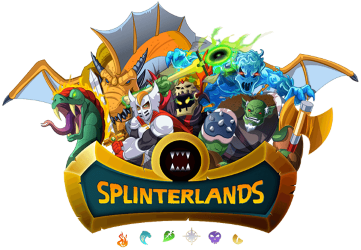Splinterlands Economics: The 80/20 "Rule"
Hello everyone! We are back again today with another edition of Splinterland Economics - a series in which we introduce a basic economic concept and then apply it to Splinterlands. If this is your first time reading, just to tell you a little bit about myself: my day job is in an unrelated area but I consider myself a little bit of economics nerd - I read a little (or maybe way, way) more news than I should, double majored in econ, and am obsessed with optimization. I love the way Splinterlands is equal parts card game and resource allocation game. My goal with these articles is to share a little bit of what I know with you all.
Our subject today is something you may see in business as well as economics, and has provides some interesting insights into the way things are distributed. It also has plenty of applications in optimization problems. Today, we'll be talking about the 80/20 rule, also known at the "Pareto principle".

What is the 80/20 rule?
While it may be called the 80/20 "rule", it is not so much a rule as it is an observation - many times, you will see 80% of the relevant results of something come from 20% of the causes or inputs. For example, a store may make 80% of its revenue from 20% of its customers. Or 80% of the world's income may be earned by 20% of the world's population. This isn't limited to money either - on a server, 80% of the load may come from 20% of the code, or 80% of workplace accidents may occur in 20% of the possible areas of danger.

As you may guess from the quotation marks I used in the title, the 80/20 rule comes with a number of caveats. I would like to emphasize here that despite the name, it is not a RULE. Instead it is just a tendency - sometimes it is accurate, and sometimes it is not. Another warning here is that while the 20% causing the 80% of outcomes is the focus of the rule, that does not mean that the 20% is the only thing that matters - you should still be sure to account for the other 80% of inputs or scenarios. While noticing or applying the 80/20 rule, remember the big picture!
I will have to admit that for much of my college career, the "80/20 Rule" was, for the most part, a buzzword that business majors would throw out to make things sound smarter (apologies to any business majors who happen to be reading this!). It turns out that it does, however, have some big applications. What is important, and most of what we'll be focusing on today, is observing uneven distributions, recognizing it, and taking advantage of it. If you are able to do all three of these steps then you will have a much better chance of optimally allocating your time and resources for the greatest impact.
How do we apply it to Splinterlands?

The economic side of Splinterlands is a game of resource allocation, and being able to recognize instances where the 80/20 rule applies can help us to identify places where we can apply our efforts to achieve the greatest possible impact. This can be applied in a variety of places - from our card choices, to crypto allocations, and even time management.
For example, while you are playing your ranked battles you may notice that you are using some cards or splinters much more than others. If you remember this and note it somewhere, then when you are deciding which new cards to buy or rent then you may want to consider obtaining or leveling up copies of those cards in order to get the greatest benefit from your investment. If you expect an oversized portion of price increases to be focused on a particular area - for example, in a specific asset such as SPS, or a particular subsection of cards (recently, Untamed cards come to mind), then you may see better returns by allocating (or even reallocating) additional resources to that area.
Finally, remember that your time is also a limited resource. Identifying which activities give you the greatest bang for your (metaphorical) buck can be a great indicator of which areas you may want to spend most of your efforts on. Depending on your situation you may find it best to focus on ranked or tournament play, blogging, market research, or some other area. And don't forget that if you're playing for entertainment, then you should factor "fun" into your calculations, and not just your account balances!
Why should we care?

While you should keep the caveats in mind that the rule won't always apply and that there is oftentimes still reason to pay attention to the other 20%, identifying which scenarios or items may be overrepresented in relevant outcomes is a strong clue as to which directions may be the most productive.
As I briefly mentioned earlier, identifying instances of the 80/20 rule allows us to more optimally allocating our time and resources in order to earn the greatest returns and/or get the most enjoyment out of our activities - both in Splinterlands and elsewhere. Whether it's playing a game, deciding how to spend our free time, or planning out projects at work, it is helpful to keep an eye out for instances of the 80/20 rule occurring and to think about whether we can use it in order to better order our priorities.
Thank you so much for reading all the way to the end. Interested in seeing some more of my writing in the future? Be sure to give me a follow! In the meantime, if you'd like to see some of my recent posts:
Playing with Fire - Using Scavo Firebolt in Battle! - Last week's battle challenge, featuring Scavo Firebolt!
Splinterlands Economics: Network Effects - An look into network effects, and how we can can apply them to Splinterlands.
Splinterlands Economics: Anchoring - An introduction to anchoring, and how we can can apply it to Splinterlands.
Thinking about giving Splinterlands a try but haven't signed up yet? Feel free to use my referral link: https://splinterlands.com?ref=bteim, and be sure to reach out to me if you have any questions!
All images used in this article are open source and obtained from Pixabay or Unsplash. Thumbnails borrowed with permission from the Splinterlands team or made in Canva.
Do you know the legal name of @themarkymark ???? It is needed to contact his local police station. Any information to his whereabouts would be much appreciated.
Cool post!
!PIZZA
Thank you! 😁
PIZZA Holders sent $PIZZA tips in this post's comments:
@eijibr(2/5) tipped @bteim (x1)
Join us in Discord!
Thanks for sharing! - @yonilkar
